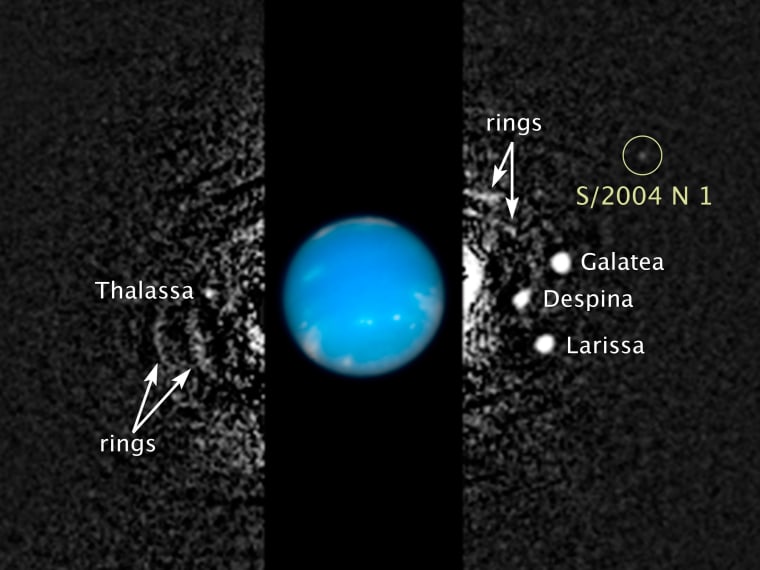An astronomer has discovered Neptune's smallest known moon, a mini-world that eluded detection until it was found almost by accident in years-old imagery from the Hubble Space Telescope.
Neptune's 14th moon, currently known only as S/2004 N 1, is thought to measure no more than 12 miles (20 kilometers) across. It orbits about 65,400 miles (105,250 kilometers) from the ice giant, between the larger Neptunian moons Larissa and Proteus.
Mark Showalter, an astronomer at the SETI Institute, came across images of the moon on July 1 while looking through Hubble imagery to trace Neptune's faint arcs, or segments of rings.
"The moons and arcs orbit very quickly, so we had to devise a way to follow their motion in order to bring out the details of the system," Showalter explained in a Monday news release announcing the find. "It's the same reason a sports photographer tracks a running athlete — the athlete stays in focus, but the background blurs."
On a whim, Showalter looked far beyond the ring segments and noticed an intriguing white dot. That led him to check more than 150 archival photographs taken by Hubble from 2004 to 2009, tracking how the dot moved over the course of those five years.
The dot turned out to be a fast-moving moon that circles Neptune every 23 hours. It had gone unnoticed when NASA's Voyager 2 spacecraft flew past the Neptunian system in 1989 — in large part because it's so small. At an estimated magnitude of 26.5, the moon is roughly 100 million times fainter than the faintest star that can be seen by the naked eye, NASA says.
The Hubble imagery has been publicly accessible for years. All it required was a sharp-eyed observer to spot the moon's track over time. "Anyone could have discovered this," a modest Showalter told Sky & Telescope.
Showalter is a veteran moon discoverer: He was part of the discovery team for a moon of Saturn (Pan), two moons of Uranus (Mab and Cupid) and two moons of Pluto (the recently named Styx and Kerberos). His Neptunian discovery earns him the right to propose a formal name to the International Astronomical Union for S/2004 N1 as well.
More about Neptune:
- How Neptune's mighty winds blow
- There are 16 hours in Neptune's 'day'
- Flash interactive: The new solar system
Alan Boyle is NBCNews.com's science editor. Connect with the Cosmic Log community by "liking" the NBC News Science Facebook page, following @b0yle on Twitter and adding +Alan Boyle to your Google+ circles. To keep up with NBCNews.com's stories about science and space, sign up for the Tech & Science newsletter, delivered to your email in-box every weekday. You can also check out "The Case for Pluto," my book about the controversial dwarf planet and the search for new worlds.
